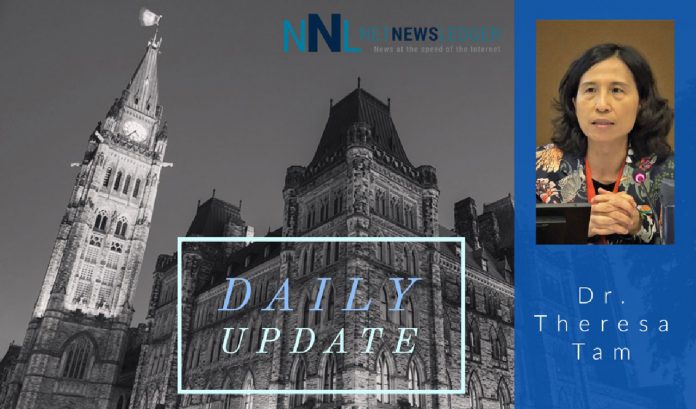OTTAWA – COVID- 19 – In lieu of an in-person update to the media, Dr. Theresa Tam, Canada’s Chief Public Health Officer, issued the following statement today:
“As the resurgence of COVID-19 activity continues in Canada, we are tracking a range of epidemiological indicators to monitor where the disease is most active, where it is spreading and how it is impacting the health of Canadians and public health, laboratory and healthcare capacity. The following is the latest summary on national numbers and trends, and the actions we all need to be taking to maintain COVID-19 at manageable levels across the country.
Since the start of the pandemic, there have been 260,055 cases of COVID-19, including 10,490 deaths reported in Canada; these cumulative numbers tell us about the overall burden of COVID-19 illness to date. Though the cumulative number is high and continues to increase, with several regions experiencing accelerated growth, it is important to remember that the vast majority of Canadians remain susceptible to COVID-19. This is why it is important for everyone to continue with individual precautions that will keep ourselves, our families and our communities safer.
At this time, there are 36,471 active cases across the country. The latest national-level data indicate daily averages of >3,350 new cases (Oct 30-Nov 5) and close to 61,000 people tested, with 4.7% testing positive (Oct 25-31). Although the size can vary from just a few cases to larger clusters, outbreaks are being reported in a range of settings including long-term care and assisted living facilities, schools, congregate living settings, industrial work settings and large social gatherings.
As our activities move indoors during the colder weather, I am advising Canadians to avoid the 3Cs settings wherever possible; larger clusters tell us that closed spaces with poor ventilation, crowded places where many people gather and close contact situations can amplify spread of the virus. Spread in informal social gatherings and activities is also occurring. In these more relaxed settings, such as family and holiday celebrations and recreational activities, letting our guard down and not consistently maintaining public health practises, such as physical distancing and mask wearing, can lead to many exposures and infections. For these reasons, I am recommending that everyone wear a non-medical mask or face covering when spending time indoors with people from outside of your immediate household.
The number of people experiencing severe illness continues to increase. Provincial and territorial data, indicate that an average of 1,200 people with COVID-19 were being treated in Canadian hospitals each day during the most recent 7-day period (Oct 30-Nov 5), including 225 of whom were being treated in intensive care units. During the same period, there were an average of 44 COVID-19-related deaths reported daily.
As hospitalisations and deaths tend to lag behind increased disease activity by one to several weeks, the concern is that we have yet to see the extent of severe impacts associated with the ongoing increase in COVID-19 disease activity. As well, influenza and respiratory infections typically increase during the Fall and Winter, placing increased demands on hospitals. This is why it is so important for people of all ages to maintain public health practices that keep respiratory infection rates low.
Canada needs a collective effort to support and sustain the public health response through to the end of the pandemic, while balancing the health, social and economic consequences. To do this, we need to retake the lead on COVID-19, by each reducing our close contacts to the best of our ability and employing key public health practices consistently and with precision: stay home/self-isolate if you have any symptoms, maintain physical distancing, wear a face mask as appropriate, and keep up with frequent hand, cough and surface hygiene.
Canadians can also go the extra mile by sharing credible information on COVID-19 risks and prevention practises and measures to reduce COVID-19 in communities and by downloading the COVID Alert app to help limit the spread of COVID-19.
What comes next for us this Fall and Winter is for everyone of us to determine, through our decisions and actions. Let’s bring COVID-19 down, together! Read my backgrounder to access more COVID-19 Information and Resources on ways to reduce the risks and protect yourself and others.
And finally, for Veterans’ Week (November 5 – 11), I encourage Canadians to take time to honour those who have served Canada, past and present, during times of war, conflict and peace. This year is the 75th anniversary of the end of the Second World War. This year commemorative events have been adapted to mitigate COVID-19 risks, including some events moving online to enable virtual participation. Learn more about commemorative services and activities at Veteran Affairs Canada.”
SOURCE Public Health Agency of Canada







